The AMD Radeon RX 480 Preview: Polaris Makes Its Mainstream Mark
by Ryan Smith on June 29, 2016 9:00 AM ESTPower, Temperature, & Noise
Given AMD’s focus on power efficiency with Polaris – not to mention the overall benefits of the move to 14nm FinFET – there is a lot of interest in just how the RX 480 stacks up when it comes to power, temperature, and noise. So without further ado…

When it comes to idle power consumption I'm posting the results I've measured as-is, but I want to note that I have low confidence in these results for the AMD cards. Ever since the GPU testbed was updated from Windows 8.1 to Windows 10, AMD cards have idled 3-5W higher than they used to under Windows 8.1. I believe that this is an AMD driver bug – NVIDIA’s cards clearly have no problem – possibly related to the GPU tested being an Ivy Bridge-E system. In this case I don’t believe RX 480’s idle power consumption is any higher than GTX 960’s, but for the moment the testbed is unable to prove it.
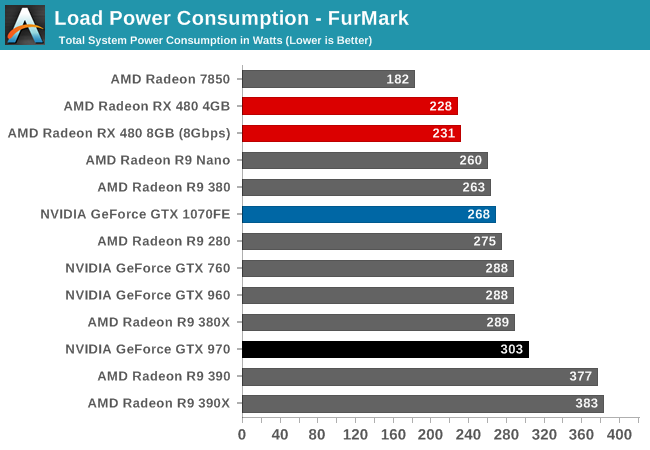
Traditionally we start with gaming load power before moving on to FurMark, but in this instance I want to flip that. As a power virus type workload, FurMark’s power requirements are greater than any game. But because it’s synthetic, it gives us a cleaner look at just GPU power consumption.
Among AMD’s cards, the RX 480 is second to only the Radeon HD 7850 in power consumption. Even then, as a GCN 1.0 card, the 7850 is one of the last AMD cards without fine-grained power states, so this isn’t a true apples-to-apples comparison. Instead a better point of reference is the GCN 1.2 based R9 Nano, which has a 175W TBP. Compared to the R9 Nano we find that the RX 480 draws about 30W less at the wall, which almost perfectly translates to the 25W difference in TBP. As a result we can see first-hand the progress AMD has made on containing power consumption with Polaris.
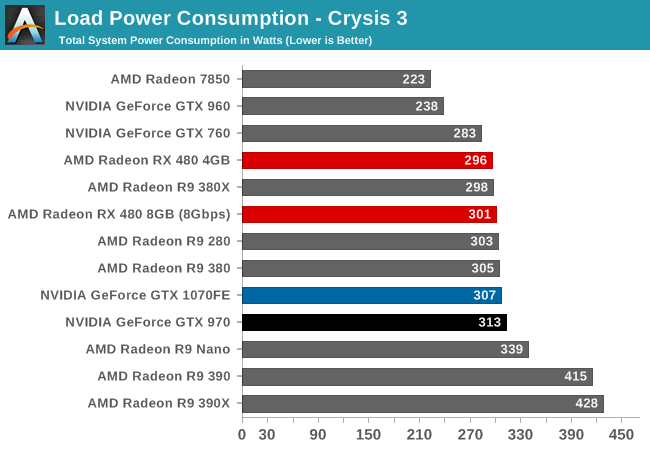
However things are a bit more mixed under Crysis 3. RX 480 is still near the top of our charts, and keeping in mind that higher performing cards draw more power on this test due to the additional CPU workload, the RX 480 compares very favorably to the rest of AMD’s lineup. System power consumption is very close to R9 280/380 for much improved performance, and against the performance-comparable R9 390, we’re looking at over 110W in savings. Hawaii was a solid chip from a performance standpoint, and Polaris 10 picks up where that left off by bringing down the power consumption to much lower levels.
The drawback for AMD here is that power consumption compared to NVIDIA still isn’t great. At the wall, RX 480 is only about 10W ahead of the performance-comparable GTX 970, a last-generation 28nm card. 1070FE further complicates matters, as its performance is well ahead of RX 480, and yet its power consumption at the wall is within several watts of AMD’s latest card. Given what we saw with FurMark I have little reason to believe that card-level power consumption is this close, but it looks like AMD is losing out elsewhere; possibly with driver-related CPU load.
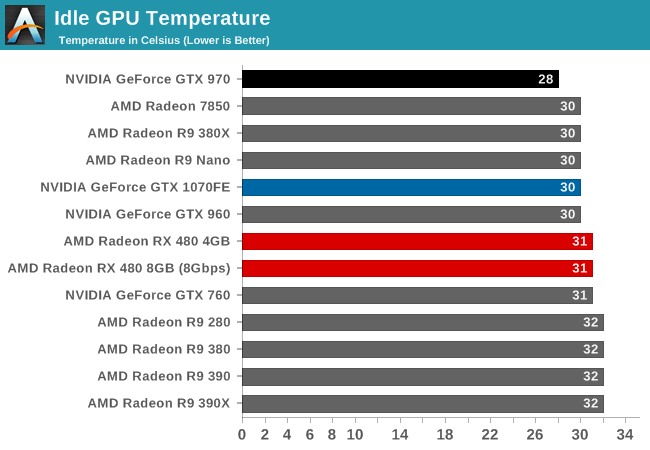
Moving on to idle GPU temperatures, there’s little to remark on. At 31C, the RX 480’s blower based design is consistent with the other cards in our lineup.
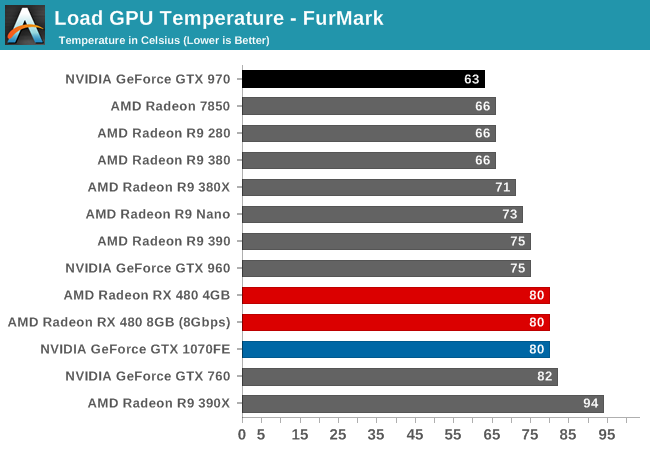
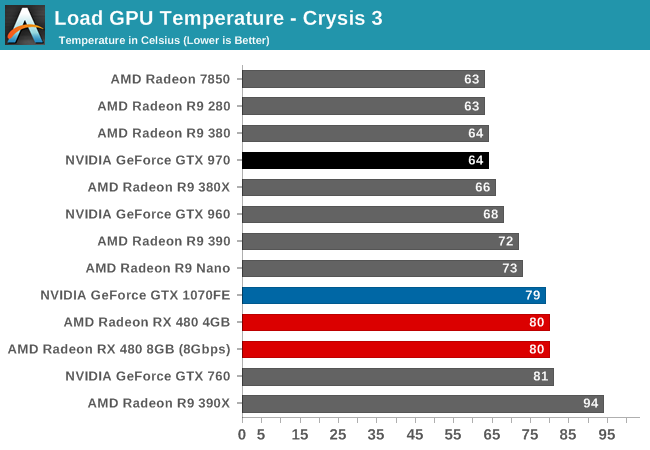
Meanwhile with load temperatures, we get to see the full impact of AMD’s new WattMan power management technology. The RX 480 has a temperature target of 80C, and it dutifully ramps up the fan to ensure it doesn’t exceed that temperature.

With idle noise levels RX 480 once again posts a good result. At 37.8dB, it’s in good company, only meaningfully trailing cards that idle silently due to their respective zero fan speed idle implementations.
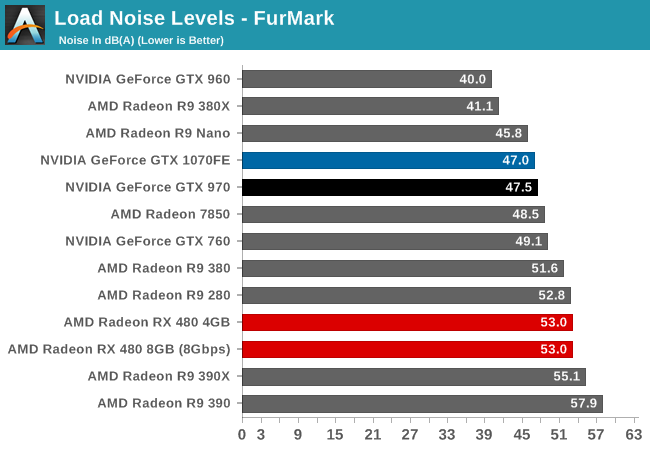
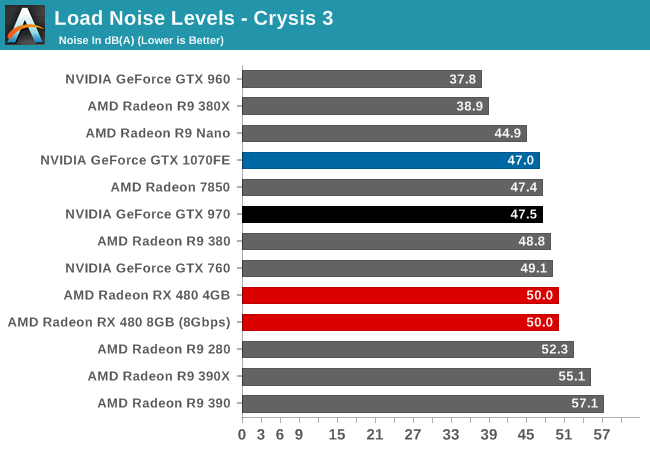
Finally, with load noise levels, RX 480 produces middling (but acceptable) results. Given that we have a mix of blowers and open air coolers here, the RX 480 performs similarly to other mainstream blower based cards. The $199 price tag means that AMD can’t implement any exotic cooling or noise reduction technologies, though strictly speaking it doesn’t need them.










449 Comments
View All Comments
Demibolt - Friday, July 1, 2016 - link
Not here to argue, just fact checking.GTX 970 is currently in the top 3 cards used by Steam users (according to Steam's reports).
The GTX 970 can currently be purchased for ~$240 from several online retailers.
TimAhKin - Wednesday, June 29, 2016 - link
The 480 was never meant to compete with Pascal.This card is for people that want to upgrade from older GPUs. It's a pretty cheap card that's good for 1080p and VR.
Fallen Kell - Wednesday, June 29, 2016 - link
This is a horrible card for VR. It can barely do 60 FPS at 1080p, which isn't even in the same ballpark of doing the 90-120 FPS at 2160x1200 that is needed for VR. The card would need to be 3-4x higher performance than it currently is to pull off VR.Meteor2 - Wednesday, June 29, 2016 - link
No, you need 90 fps minimum for VR and the 480 does it at the resolutions used by the Rift and Vive just fine.DigitalFreak - Wednesday, June 29, 2016 - link
The 480 does 90fps @ 2160x1200? WTF are you smoking?Fallen Kell - Thursday, June 30, 2016 - link
I know, seriously. I don't know what Meteor2 or TimAhKin are smoking, as it is obviously the fanboy weed. There is only a single game that was benchmarked at 1080p where the 480 could even hit 90+ fps, and everything else was between 40-70 fps. And VR has 25% more pixels than 1080p.I mean, if the 480 was getting 120-130 fps at 1080p, then I would agree that it might be a decent VR card. But it averages about 1/3rd that on current AAA titles (or less with highest video quality settings enabled). This is why I said it needed to be 3-4x higher performance than what it is to do VR. Anyone using this for VR will have to turn down the video quality WAY down, which means you will see much more item/object popping due to object draw distances being so low, which destroys the immersion sense that VR is attempting to create in the first place. Add in the slideshows you will get during effects heavy scenes and get ready for the vomit comet to commence due to the eyes not seeing the results of your head moving.
Meteor2 - Thursday, June 30, 2016 - link
I'm going by the Occulus benchmarks. You know, the one by the people who make the VR headsets.killeak - Thursday, June 30, 2016 - link
Well, they said that this would be an entry level VR card, and for that I take using low settings but 90fps at VR Resolution, and I think it's possible to consider the RX 480 (just as the 970) an entry level VR card.Now, if we are talking high/ultra settings, then no, it won't make it.
pashhtk27 - Thursday, June 30, 2016 - link
And for 90fps on high settings, you have 1080. You sure should smoke cash.Yojimbo - Thursday, June 30, 2016 - link
You are looking at benchmarks with all settings maxed out. The RX 480 is entirely capable at running 90fps @ 2160x1200 with settings selected more judiciously.